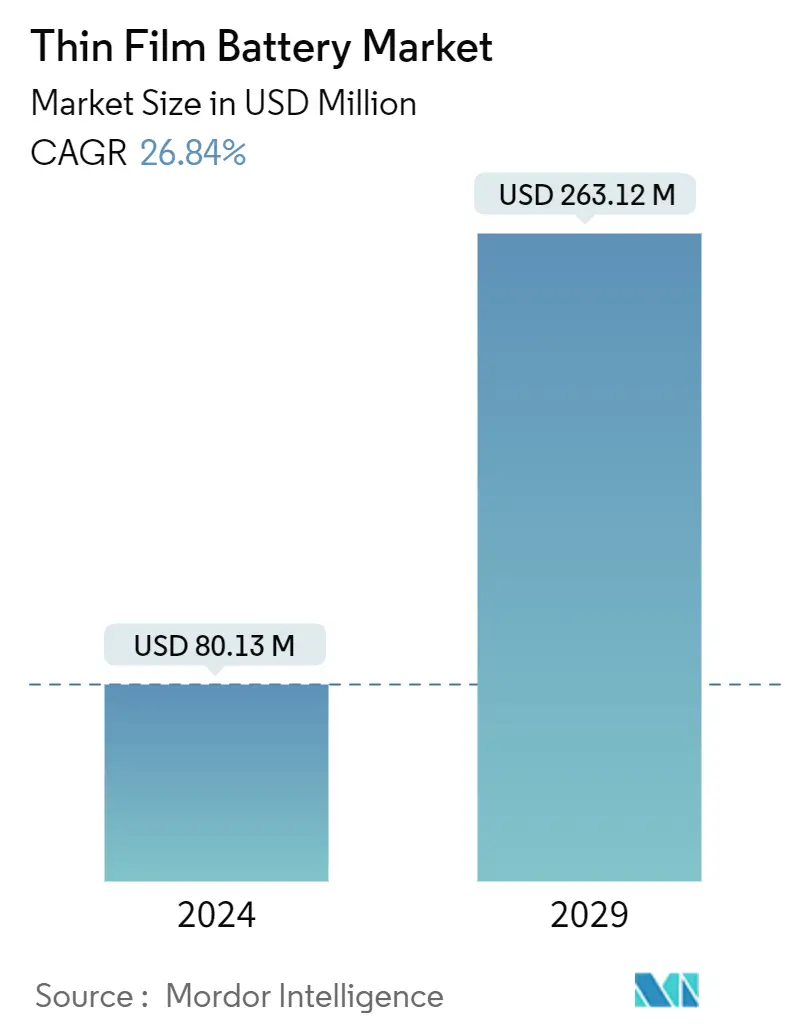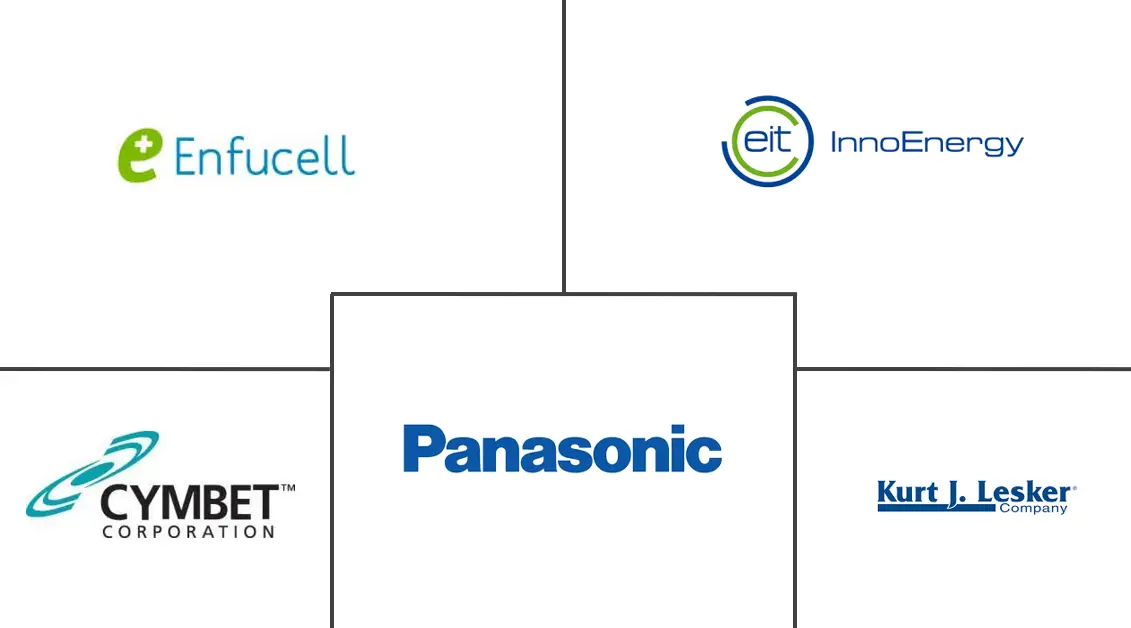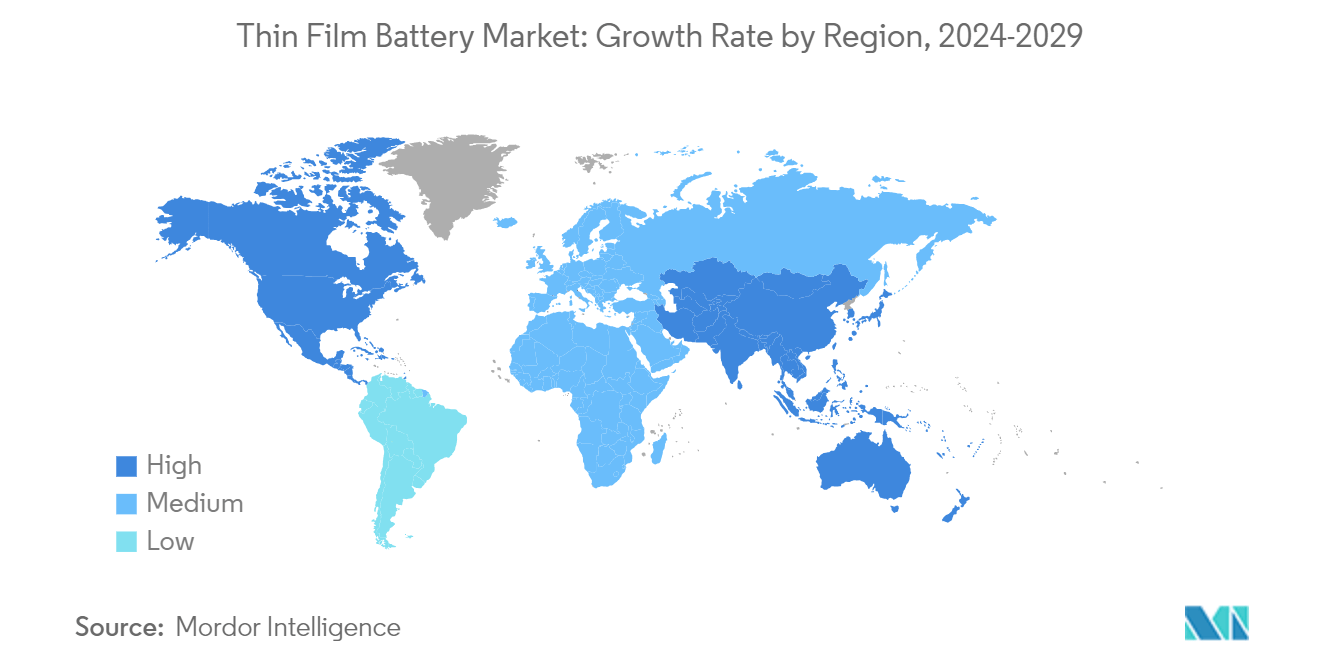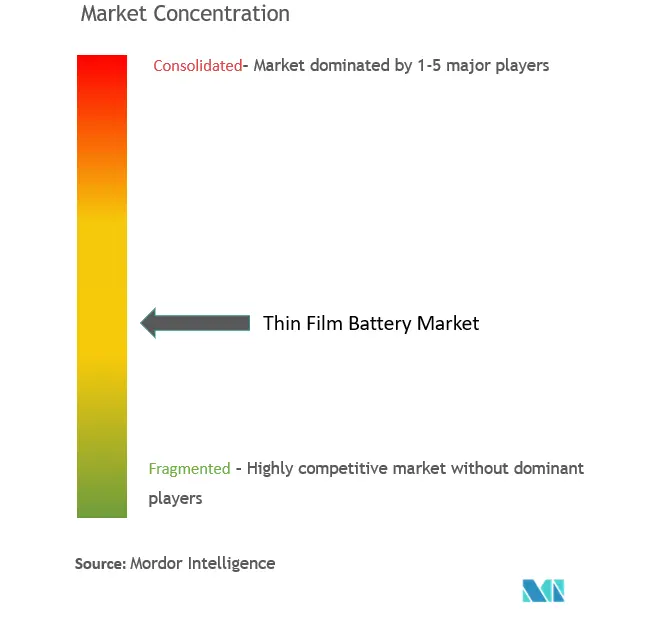Thin Film Battery Market Size

| Study Period | 2019 - 2029 |
| Market Size (2024) | USD 80.13 Million |
| Market Size (2029) | USD 263.12 Million |
| CAGR (2024 - 2029) | 26.84 % |
| Fastest Growing Market | Asia Pacific |
| Largest Market | North America |
Major Players
*Disclaimer: Major Players sorted in no particular order |
Thin Film Battery Market Analysis
The Thin Film Battery Market size is estimated at USD 80.13 million in 2024, and is expected to reach USD 263.12 million by 2029, growing at a CAGR of 26.84% during the forecast period (2024-2029).
- Over the medium term, increasing demand for thin film technology in the consumer electronics sector, coupled with the penetration of Internet of Things (IoT) applications, is expected to increase the demand for the thin film battery market.
- On the other hand, the availability of alternate battery technologies is expected to hinder market growth.
- Nevertheless, the characteristics of these batteries, such as lightweight and compact designs, make them suitable for military applications, which is expected to create enormous opportunities for the thin film battery market.
- The Asia-Pacific region dominates the market and is also likely to register the highest CAGR during the forecast period. The growth is mainly due to the increasing emphasis on foldable electronics and wearables, especially across economies such as China, South Korea, and Japan.
Thin Film Battery Market Trends
Consumer Electronics Segment to Dominate the Market
- Consumer electronics are anticipated to dominate the thin film battery market due to the increasing demand for smaller, lighter, and more efficient power sources in this sector. The proliferation of portable devices, such as smartphones, wearables, and tablets, has led to a burgeoning need for compact and flexible energy solutions.
- Moreover, with the increased shipments of consumer electronics, such as smart watches, wearable health monitoring devices, and smart glasses, portable batteries are expected to witness tremendous growth globally during the forecast period. According to International Data Corporation (IDC), smartphone Shipments across the globe increased 5.7 times compared to 2009.
- The tendency toward miniaturization in consumer electronics has resulted in a need for efficient power sources that can adapt to diverse characteristics and design requirements. Thin-film batteries, with their thinness, flexibility, and customizable shapes, perfectly meet this demand, facilitating their seamless integration into a comprehensive array of consumer electronic gadgets.
- For instance, in August 2023, a group of scientists from German and British universities announced that they had completed the development of T-Nb2O5 thin films, facilitating the accelerated movement of Li-ion, a noteworthy stride forward. This breakthrough holds the potential for enhanced batteries and progress in computing and lighting, signifying a considerable advancement in consumer electronics. Forecasts suggest a boost in battery energy density and recharge cycles, offering substantial prospects in the consumer electronics sector.
- Moreover, the evolving landscape of consumer preferences emphasizes convenience, longer device lifespans, and a desire for more sustainable energy solutions. Thin film batteries, with their potential for improved energy density and longer cycle life, meet these consumer demands by offering extended device usage and reduced environmental impact compared to traditional bulky batteries.
- The market's dominance by consumer electronics is also influenced by the expanding global penetration of these devices, especially in emerging economies. The increasing consumer base in these regions demands devices that are not only affordable but also equipped with reliable and durable power sources.
- Therefore, as per the points mentioned above, the consumer electronics market segment is expected to dominate the market during the forecast period.

Asia-Pacific to be the Fastest-Growing Region
- The Asia-Pacific region is poised to witness remarkable growth in the thin film battery market, attributed to various factors contributing to its expanding dominance in this sector. One of the primary driving forces is the burgeoning consumer electronics industry in countries like China, Japan, South Korea, and India.
- Thin film batteries, which contain ceramic electrolytes, are known as ceramic batteries. Ceramic materials have high melting points due to their strong covalent bonds, which allows these batteries to operate at very high temperatures. Using ceramic batteries in electric vehicles has several advantages compared to other battery technology. According to IEA, the total electric car sales reached more than 10 million in 2022, led by the Asia Pacific region. A total of 14% of all new cars sold were electric in 2022, up from around 9% in 2021 and less than 5% in 2020.
- Wearable devices will likely emerge as significant consumers of thin film batteries and are witnessing substantial growth in China. For instance, according to the International Data Corporation (IDC), China's shipments of wearable devices went up 7.5% year on year to reach 34.7 million units in the third quarter (Q3) of 2023. In July-September, China shipped over 19.24 million units of ear-worn devices, an expansion of 9.8% year on year.
- Furthermore, the rapid industrialization and technological advancements in the Asia Pacific region have paved the way for substantial innovations and investments in research and development activities related to thin film battery technologies.
- Wearable devices have been experiencing considerable adoption over the past few years in India, and it is anticipated they will remain an attractive potential end-use application industry. For instance, according to the International Data Corporation (IDC), the Indian wearable market saw a 34% growth, recording 134.2 million units in 2023. The average selling price of wearables dropped over 15% to USD 21.2. This scenario will likely increase the adoption of such devices and remain an attractive market for many flexible small batteries.
- In April 2023, the Government of India approved the National Medical Devices Policy, 2023, which will likely facilitate the growth of the medical device sector to meet the public health objectives of access, quality, affordability, and innovation. Further, this sector is expected to realize its potential, with strategies for developing an enabling ecosystem for manufacturing, focusing on creating a robust regulatory framework and innovation and offering support through training and capacity-building programs. Encouraging domestic investments and medical device production complements the Indian government’s Atmanirbhar Bharat and Make in India programs.
- For instance, the Japanese government revealed in February 2023 a battery strategy budget totaling USD 2.55 billion designated for the research and development of new battery technologies, encompassing diverse types such as all-solid-state lithium batteries, thin film batteries, and a range of emerging battery technologies. This initiative is anticipated to bolster Japan's position in the realm of battery technology.
- Moreover, the Asia-Pacific region's strong manufacturing capabilities, coupled with a favorable regulatory environment and a robust supply chain infrastructure, position it as a hub for thin-film battery production. Cost-effective manufacturing processes, increasing investments in technological advancements, and a growing emphasis on environmentally friendly energy sources reinforce the region's foothold in the thin-film battery market.
- Therefore, as per the points mentioned above, the Asia-Pacific Region is expected to witness significant growth during the forecast period.

Thin Film Battery Industry Overview
The thin film battery market is semi-consolidated. Some major players in the market (in no particular order) include Enfucell OY Ltd., EIT InnoEnergy SE, Cymbet Corporation, Inc., Kurt J. Lesker Company, and Panasonic Corporation, among others.
Thin Film Battery Market Leaders
-
Enfucell OY Ltd.
-
Enfucell OY Ltd.
-
Cymbet Corporation, Inc.
-
Kurt J. Lesker Company
-
Panasonic Corporation
*Disclaimer: Major Players sorted in no particular order

Thin Film Battery Market News
- February 2024: LionVolt, a Dutch startup, started developing 3D solid-state batteries made up of a thin film containing billions of solid pillars, creating a patented 3D architecture with a large surface area. The company also raised EUR 15 million (USD 16 million) to scale up the production of these batteries.
- January 2024: Battery start-up BTRY raised CHF 900,000 in pre-seed financing to develop safe, long-lasting thin-film solid-state batteries that can be charged and discharged in one minute. The company has developed thin-film cells, which are only a few micrometers thick, into more powerful batteries. It has also developed a process that uses high-precision vacuum coating and no toxic solvents.
Thin Film Battery Market Report - Table of Contents
1. INTRODUCTION
- 1.1 Scope of the Study
- 1.2 Market Definition
- 1.3 Study Assumptions
2. RESEARCH METHODOLOGY
3. EXECUTIVE SUMMARY
4. MARKET OVERVIEW
- 4.1 Introduction
- 4.2 Market Size and Demand Forecast in USD, till 2029
- 4.3 Recent Trends and Developments
- 4.4 Government Policies and Regulations
-
4.5 Market Dynamics
- 4.5.1 Drivers
- 4.5.1.1 Increasing Demand For Thin Film Technology in Consumer Electronics Sector
- 4.5.1.2 Growing Internet of Things Applications
- 4.5.2 Restraints
- 4.5.2.1 Availability of Alternate Battery Technologies
- 4.6 Supply Chain Analysis
-
4.7 Porter's Five Forces Analysis
- 4.7.1 Bargaining Power of Suppliers
- 4.7.2 Bargaining Power of Consumers
- 4.7.3 Threat of New Entrants
- 4.7.4 Threat of Substitutes Products and Services
- 4.7.5 Intensity of Competitive Rivalry
5. MARKET SEGEMENTATION
-
5.1 Battery Type
- 5.1.1 Rechargeable
- 5.1.2 Non-Rechargeable
-
5.2 Technology
- 5.2.1 Printed Battery
- 5.2.2 Ceramic Battery
- 5.2.3 Lithium Polymer Battery
- 5.2.4 Other Technologies
-
5.3 Application
- 5.3.1 Consumer Electronics
- 5.3.2 Medical Devices
- 5.3.3 Wearable Technology
- 5.3.4 Smart Card
- 5.3.5 RFID
- 5.3.6 Other Applications
-
5.4 Geography
- 5.4.1 North America
- 5.4.1.1 United States
- 5.4.1.2 Canada
- 5.4.1.3 Rest of North America
- 5.4.2 Europe
- 5.4.2.1 Germany
- 5.4.2.2 France
- 5.4.2.3 United Kingdom
- 5.4.2.4 Italy
- 5.4.2.5 Spain
- 5.4.2.6 Nordic
- 5.4.2.7 Turkey
- 5.4.2.8 Russia
- 5.4.2.9 Rest of Europe
- 5.4.3 Asia-Pacific
- 5.4.3.1 China
- 5.4.3.2 India
- 5.4.3.3 Japan
- 5.4.3.4 South Korea
- 5.4.3.5 Malaysia
- 5.4.3.6 Thailand
- 5.4.3.7 Indonesia
- 5.4.3.8 Vietnam
- 5.4.3.9 Rest of Asia-Pacific
- 5.4.4 Middle-East and Africa
- 5.4.4.1 Saudi Arabia
- 5.4.4.2 United Arab Emirates
- 5.4.4.3 Nigeria
- 5.4.4.4 Qatar
- 5.4.4.5 Egypt
- 5.4.4.6 Rest of Middle East and Africa
- 5.4.5 South America
- 5.4.5.1 Brazil
- 5.4.5.2 Colombia
- 5.4.5.3 Argentina
- 5.4.5.4 Rest of South America
6. COMPETITIVE LANDSCAPE
- 6.1 Mergers and Acquisitions, Joint Ventures, Collaborations, and Agreements
- 6.2 Strategies Adopted by Leading Players
-
6.3 Companies Profiles
- 6.3.1 EIT InnoEnergy SE
- 6.3.2 Enfucell OY Ltd.
- 6.3.3 Kurt J. Lesker Company
- 6.3.4 Cymbet Corporation, Inc.
- 6.3.5 Imprint Energy, Inc.
- 6.3.6 Ilika Plc
- 6.3.7 STMicroelectronics
- 6.3.8 BASQUEVOLT
- 6.3.9 The Batteries Sp. z o. o
- 6.3.10 Panasonic Corporation
- 6.4 Market Ranking Analysis
7. MARKET OPPORTUNITIES AND FUTURE TRENDS
- 7.1 Growing Adoption in Military and Defense Application
Thin Film Battery Industry Segmentation
Thin film batteries are a type of energy storage device that is characterized by their light and flexible nature. They are made using thin layers of various materials deposited on a substrate, usually through a process called physical vapor deposition or chemical vapor deposition. These batteries typically use solid-state technology and offer advantages such as flexibility, small form factors, and the ability to be integrated into various devices and applications.
The thin film battery market is segmented by battery type, technology, application, and geography (North America, Europe, Asia-pacific, Europe, South America, And the Middle East and Africa). By battery type, the market is segmented into rechargeable and non-rechargeable. By technology, the market is segmented into printed batteries, ceramic batteries, lithium polymer batteries, and other technologies. By application, the market is segmented into consumer electronics, medical devices, wearable technology, smart card, RFID, and other applications. The report also covers the market size and forecasts for the thin film battery market across major regions.
For each segment, the market sizing and forecasts have been done based on revenue (USD).
Thin Film Battery Market Research FAQs
How big is the Thin Film Battery Market?
The Thin Film Battery Market size is expected to reach USD 80.13 million in 2024 and grow at a CAGR of 26.84% to reach USD 263.12 million by 2029.
What is the current Thin Film Battery Market size?
In 2024, the Thin Film Battery Market size is expected to reach USD 80.13 million.
Who are the key players in Thin Film Battery Market?
Enfucell OY Ltd., Enfucell OY Ltd., Cymbet Corporation, Inc., Kurt J. Lesker Company and Panasonic Corporation are the major companies operating in the Thin Film Battery Market.
Which is the fastest growing region in Thin Film Battery Market?
Asia Pacific is estimated to grow at the highest CAGR over the forecast period (2024-2029).
Which region has the biggest share in Thin Film Battery Market?
In 2024, the North America accounts for the largest market share in Thin Film Battery Market.
What years does this Thin Film Battery Market cover, and what was the market size in 2023?
In 2023, the Thin Film Battery Market size was estimated at USD 58.62 million. The report covers the Thin Film Battery Market historical market size for years: 2019, 2020, 2021, 2022 and 2023. The report also forecasts the Thin Film Battery Market size for years: 2024, 2025, 2026, 2027, 2028 and 2029.
Thin Film Battery Industry Report
Statistics for the 2024 Thin Film Battery market share, size and revenue growth rate, created by Mordor Intelligence™ Industry Reports. Thin Film Battery analysis includes a market forecast outlook to for 2024 to 2029 and historical overview. Get a sample of this industry analysis as a free report PDF download.



